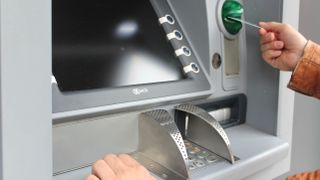Know your adversary: exploring the 5 most widely employed tactics in identity theft crimes
What are the methods used by criminals to steal your identity?

To steal your identity, cybercriminals rely on catching you off guard. Even a momentary lapse of attention could result in you giving away the necessary information without realizing it.
Identity theft is a scam that thrives on taking advantage of people when they least expect it. Cybercriminals employ various tactics to steal your identity and access to your bank account. Here are five of the most common identity theft techniques you should know.
1. Phishing
Phishing emails and text messages can trick you into revealing your personal information. Scammers create fake websites of banks, credit card companies, PayPal, and eBay by copying their logos and designs. They then send you an urgent and genuine-looking message asking you to fill in a form with your details. If you fall for it, you give away your data without realizing it.
To avoid phishing scams, be cautious of any message that asks for your personal information. Don't click on any links in emails or messages that claim to be from your bank, PayPal, or any other financial institution. Instead, open a new browser window and log in to your account to verify the details of the message. Be on the lookout for grammatical, spelling, and formatting issues, which are tell-tale signs of a phishing attempt.

2. Skimming
Cybercriminals don't need to physically steal your credit card anymore. They use technology to clone its details. Once they get this information, they can use it to create a duplicate card or use it at the checkout of an online store.
But how is this possible? These days, criminals use lightweight machines that can fit in your palm to clone your card. They read the data from the black strip, which is then used to make a copy. This technique has even spread to ATMs and fuel station forecourts.
To prevent skimming, always keep your card in your hand and avoid handing it over to others. Whenever possible, use contactless payments. Finally, before using an ATM, make sure to check for false facias and skimmers.
Are you a pro? Subscribe to our newsletter
Sign up to the TechRadar Pro newsletter to get all the top news, opinion, features and guidance your business needs to succeed!
3. Social media
Social media exposes you to cybercriminals as it leaks certain information about you. Facebook is a prime example of a platform where your hometown, family, job, and spending habits can be found.
Public profiles, posts, and tags leave you vulnerable to identity theft, as anyone can find out your personal information, including places you've been, your residence, your acquaintances, and your date of birth.
Facebook has recently taken measures to enhance user privacy, but, probably, you are not using these settings correctly. To check your privacy settings, review your last Facebook post. If there is a globe icon next to the date, it implies that your post is public.
To protect your social media accounts, secure your account settings, ensuring that all information, photos, and posts can be seen only by friends. Use the "Settings > Privacy" option for Facebook to make the necessary changes. Alternatively, you may consider reducing your friend list or deleting your account.
- These are the best social media management tools
4. Shoulder surfing
Scammers can use traditional methods to steal your credit card details instead of relying on technology. One such method is "shoulder surfing," where they observe what PINs people enter into ATMs and stores. To do this, they need to get very close to the target or "mark." After all, they are looking over your shoulder!
The perpetrator must have keen eyesight to spot the digits used in your PIN. However, simply memorizing the PIN number is not enough for identity theft.
Understandably, shoulder surfing often leads to more advanced scams, such as skimming or even old-fashioned pickpocketing. Once criminals have both your card and PIN, they hold the advantage.
To prevent shoulder surfing, make sure you cover the keypad when entering your PIN at an ATM or cashier desk.

5. Unsecure networks
Despite the advancements in wireless security, unsecured networks still exist. For instance, if you are using an old router at home, it might not provide a secure WPA2 connection, and instead, you might be stuck with a vulnerable WEP connection. Similarly, your local coffee shop, library, shopping center, or even a football ground could be providing incorrectly configured Wi-Fi networks, thereby risking your online privacy.
There are various risks associated with using unsecured Wi-Fi networks, such as unsecured routers with publicly accessible backdoors that allow your data to be intercepted and read. Additionally, scammers set up fake Wi-Fi networks to trick you into sending your data via their devices.
To ensure your online privacy, it is essential to make networks secure. Upgrade your router to provide a secure connection if it's your network. If you're using a public Wi-Fi network, always use a VPN to protect your data from being intercepted.
Awareness is the key to combating identity theft
It is possible that you have come across some of the methods used for identity theft. However, you might not have thought that you could be a victim of them. This is because you may believe that you do not have much money in your bank account. Unfortunately, the truth is that it is easier to steal from ordinary people than from celebrities, football players, or wealthy individuals. Therefore, it is essential to be aware of phishing, skimming, shoulder surfing, and the risks of using unsecured networks. Additionally, it is advisable to avoid sharing too much information on social media.
More from TechRadar Pro
- Protect your privacy online with one of the best VPN services
- Keep your devices safe with the best antivirus software
- We've also highlighted the best password manager
- Also check out our complete list of the best identity theft protection
Bryan M. Wolfe is a staff writer at TechRadar, iMore, and wherever Future can use him. Though his passion is Apple-based products, he doesn't have a problem using Windows and Android. Bryan's a single father of a 15-year-old daughter and a puppy, Isabelle. Thanks for reading!

